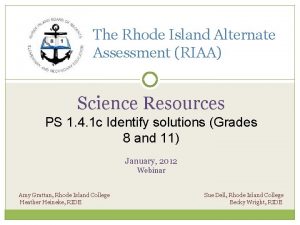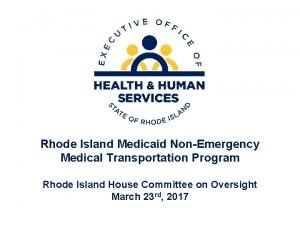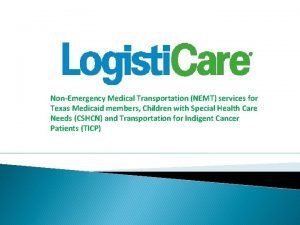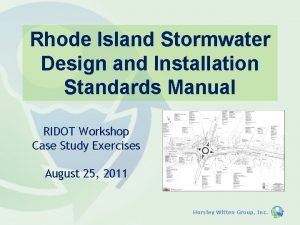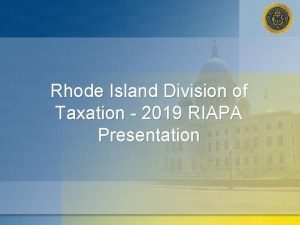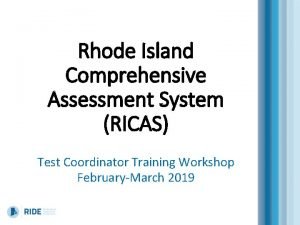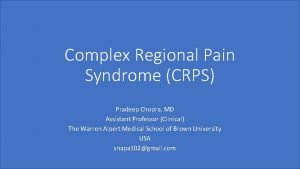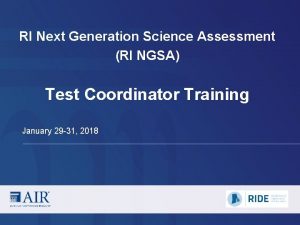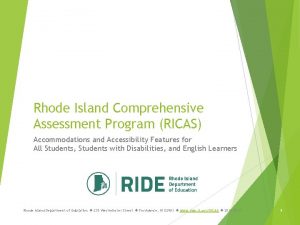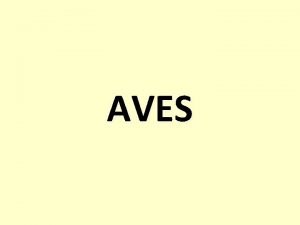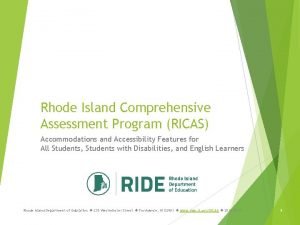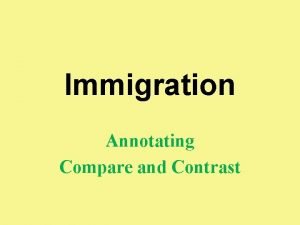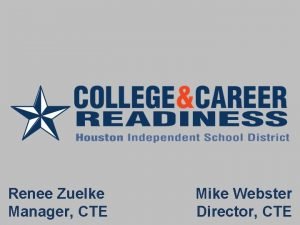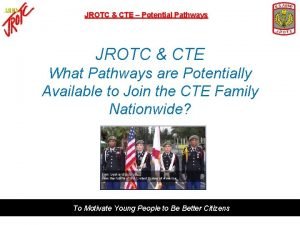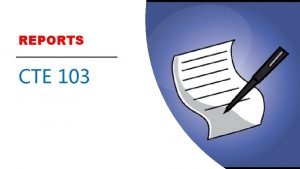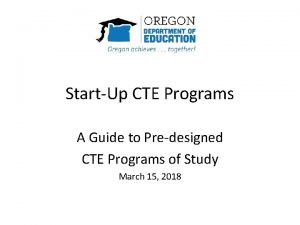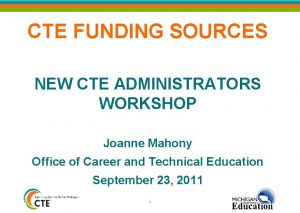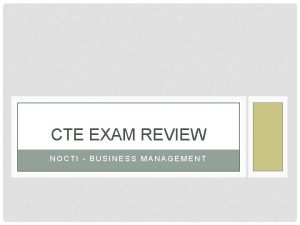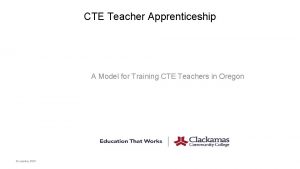The Future of CTE in Rhode Island Steve























- Slides: 23

The Future of CTE in Rhode Island Ø Steve Osborn, Chief of Innovation, RI Department of education Ø Joe Mazzone, Prepare. RI Ambassador and CTE Instructor @ Davies Career & Technical High School Ø Paul Mc. Connell, Office of College & Career Readiness, RI Department of Education 1

Presentation Objectives • Provide an overview of Prepare. RI • Overview of CTE Accountability Proposal • Overview of Work-Based Learning Shared Vision Partnership • Overview of timelines for new program approval • Q&A Next Steps 2

Prepare Rhode Island (Prepare. RI) is one of the most ambitious plans in the nation to improve youth career readiness. It represents a strategic demand-driven partnership between the Rhode Island government, private industry leaders, the public education system, universities, and nonprofits across the state. 3

Introduction Goal: Develop a CTE accountability system that uses student data and outcomes to guide RIDE’s decisions on approving or renewing CTE programs. • Current system • RIDE’s program approval process is very time-consuming and heavily focused on compliance • The process has little focus on student outcomes • Approval has no expiration for program approval; programs maintain their RIDE approval indefinitely • Proposed system • Starting in SY 2018 -19 RIDE will roll out a new CTE accountability system • The new system will focus on student outcomes but will still ensure compliance with applicable statute and CTE regulations • Programs will be approved for 5 year terms • Every 5 years programs will re-apply for renewal thereafter 4

Background • The CTE Regulations (2012) outline a CTE accountability process • Section 4. 2: “The Review and Approval Process includes, but is not limited to, the following components: 1. A self-study utilizing a RIDE-published instrument; 2. Submission of key student outcome data; and 3. An LEA application for initial or renewed approval that includes detailed program design and implementation information aligned to published career preparation program standards and RIDE application requirements. ” • Benefits of RIDE approval • School districts can operate CTE programs without RIDE approval, just as they can operate any other type of course. However RIDE approval provides two primary benefits: • • Receiving state CTE Categorical funding (but only if the program is in a high-wage, high-demand field) Accepting out-of-district student • Previous work related to CTE accountability • • In 2013 -14, RIDE convened a working group and drafted a proposed CTE accountability system In 2017, the CTE Board began approving industry-specific standards In 2017 -18, Harvard Kennedy School researchers proposed indicators for a CTE accountability system In 2018, US Congress reauthorized Perkins (Perkins V), which includes requirements about CTE accountability 5

Proposed System 6

Overview of proposed system Year 1 Annual reporting Year 2 Annual reporting Year 3 Annual reporting Year 4 Annual reporting Year 5 Application for renewal Renewal application approved 7

System Overview • New Program Application • Programs that are seeking RIDE approval for the first time complete an application about student outcomes (if the program is already running) and compliance with CTE regulations. Programs accredited by a RIDE-approved organization complete an abridged version of the application. RIDE conducts a brief (1 -2 hours) site visit. • Preexisting programs with student outcomes can receive approvals for 5 years. New programs can only receive approval for 5 years. • Annual Review • Schools submit CTE Annual Report each summer. This is primarily a data submissionbut it may include brief written components. • RIDE publishes Statewide CTE Annual Report each fall. This is a dashboard compiling data on all CTE programs in the state, and is visible to schools are parents. Schools falling significantly behind in student performance metrics may face shortened timelines for their renewal. • Program Renewal Application • At the expiration of their authorization term (5 years in most cases), all CTE programs must apply for renewal. Programs that do not apply will lose their program approval status. The renewal process is based primarily on student outcomes. Schools must also verify that they still comply with CTE regulations. • Programs that meet expectations are renewed for another 5 years. Programs that approach expectations are renewed for 5 years, but have additional conditions on their renewal. Programs that do not meet expectations are either recommended for a shortened renewal period with the requirement of creating an improvement plan or are closed. 8

Phasing in the new system • RIDE publishes baseline data in 2018 -19 • After adoption by the CTE Board of Trustees, RIDE publishes the baseline 2017 -18 Annual Performance Report. It follows up with districts to ensure the baseline data is correct. • RIDE reviews and shares data with CTE programs and with subcommittees and industry leads to coach programs identified for improvement on how to improve their student outcomes. • In Summer 2019, RIDE begins new, unified CTE data collection. Programs begins annual reporting process. • All approvals issued in 2018 become 5 -year approvals • New programs are approved through SY 2022 -23. They follow the new accountability system. • Programs approved before 2018 are reviewed over next three years, prioritized by performance • Programs are divided into three tiers, based on their performance in the baseline 2017 -18 Performance Report • The lowest-performing third of programs goes up for review next year (2019 -20), the middle third goes up the following year (2020 -21), and the highest performing the year after that (2021 -22). • The system will be fully in place by 2022 -23 • This proposal will involve reviewing all ~200 programs over four years, with about 50 programs reviewed per year 9

Phasing in the new system • 2018 -19 • Pilot year. RIDE shares baseline data and coaches program on new reporting process. • 2019 -20 • Cohort 1 programs (bottom third) go up for renewal • 2020 -21 • Cohort 2 programs (middle third) go up for renewal • 2021 -22 • Cohort 3 programs (top third) go up for renewal • 2022 -23 • System fully in place • Programs approved in 2018 go up for renewal 10

Performance Metrics 11

Role of performance metrics • The key difference between the new CTE accountability system and the previous efforts is the inclusion of both leading and lagging student performance metrics. • These metrics are the primary factor RIDE considers in approving or renewing programs. • These metrics should meet the following criteria: • • • Incentivize outcomes for children Un-game-able Transparent and are easily understand by all audiences Operationally feasible Aligning with goals for career education 12

Performance metrics The following metrics will be used for RIDE’s CTE accountability system: 1. Program Completion rate • Percent of concentrators who earn a CTE Board-recognized credential and other associated requirements as detailed by the applicable CTE Board subcommittee 2. Graduation rate • Percent of concentrators who graduate from high school (Perkins) 3. Postsecondary outcome • Employment or college enrollment in second quarter after secondary completion (Perkins) 4. Equity A. Participation gap: difference between a group’s representation among CTE participants and their representation in the entire school’s population B. Completion gap: difference between a group’s representation among CTE completers and their representation in the entire school’s population 13

Additional internal metrics Metrics that RIDE measures and will publish, but are not included in accountability system • Three course sequence • Percent of concentrators that complete a three-course CTE sequence (Perkins) • Cost effectiveness • Cost per program completer • Median cost per participant, by program type • Distribution of CTE programs within regions • Number of quality CTE programs in high-wage, high-demand industries in each region • Number of high-cost programs in same region RIDE should encourage each region to develop quality programs in each HWHD sector, but avoid duplication of high-cost programs within each region. 14

Discussion points • What counts as program “completion”? • Earning a CTE Board-recognized credential and all required subcommittee standards OR completing a three course sequence? • Considerations: credentials is a higher bar, but three course sequence rate is required by Perkins • Include wage data? • Could include a metric about the wages of program graduates • Could measure percent of graduates earning above living wage AND/OR median wage by cohort • Considerations: age of program, wages increasing over time, college enrollees skewing data downwards • Equity • Include equity as a separate metric, or as a breakout of each of the other metrics? • Should we measure the gap in completion rates? • Where is the bar? • How do we translate these quantitative metrics into star ratings or proficiency levels? • What’s the threshold for “meets expectations”? Whether the program is better than the school overall, similar CTE programs in other schools, the average CTE program, etc. ? 15

Data work needed • Unifying CTE data collections • Combining Perkins, CTE categorical, and e. RIDE data collections into a single annual CTE data collection with common definitions • Ideally, we should also set up data sharing agreements with the providers of credentials on the CTE Board list, so we can get that data without schools needing to report it • Adding new fields to CTE data collections • OCCR needs to add new fields to DATS dataset for CTE to account for programmatic changes in recent years. For example, the CTE Board standards should be incorporated into the new data collections. • Publishing baseline 2017 -18 Statewide CTE Report • This report will be used to coach programs throughout 2017 -18. • The initial run will likely contain errors. RIDE will work with programs to correct any errors, either in the program’s reported data or RIDE’s calculations. • Cleaning and reconciling CTE data from prior years • Time allowing, RIDE should begin correcting errors in CTE data from prior years 16

Work Plan 17

Tenative calendar of next steps for CTE Month September 2018 Program approval 2018 provisional programs complete work-based learning (WBL) application. RIDE begins work on 2019 new program application • OCCR completes proposal for unified CTE data collection system 2018 provisional programs submit WBL application. RIDE makes recommendations regarding full approval. RIDE releases 2019 new program application • Proposal for revised CTE data collection passes Data Governance Board DATS works on data collection and analysis for 201718 CTE Report • RIDE presents recommendations for 2018 WBL provisional approvals to CTE Board. • • • 2019 new program application due • RIDE reviews 2019 new program applications • RIDE finalizes recommendations regarding 2019 new program applications and presents to the CTE Board approves 2019 applications for new programs • • • October 2018 November 2018 December 2018 January 2019 February 2019 March 2019 April 2019 May 2019 June 2019 Data reporting • • Other • Prepare. RI Ambassador Michelle Maktilla begins coaching programs on WBL RIDE releases baseline 2017 -18 CTE Report RIDE works with programs to correct errors in CTE data • RIDE begins developing centralized enrollment system for CTE programs • • RIDE releases finalized 2017 -18 CTE Report Numbers from 2017 -18 CTE Report used for categorical fund disbursements • Draft centralized enrollment system goes to CTE Board • RIDE uses 2017 -18 CTE Report to propose authorization timelines for CTE programs approved before 2018. CTE Board approves this plan. • • Centralized enrollment system finalized Third party completes draft of updated high-wage, high-demand industries list • • Centralized enrollment system opens Updated HWHD list published • • RIDE begins training programs on how to properly report annual CTE data • Window opens for schools to report CTE data in new, unified system 18

Prepare. RI: Career Pathways for Youth Career Exploration Career Expertise Work-Based Learning 19

How did we land on work-based learning? • In the summer of 2016, we convened a Career Readiness Working Group (CRWG)of about 80 stakeholders from K 12 education, postsecondary education, non-profit sector and business/industry. The CRWG served as an advisory group for Rhode Island’s Phase One New Skills for Youth grant. • Though not initially the designated topic of the meetings, each meeting prominently featured concerns from business/industry about the soft/essential skill develop of our youth. The concerns were not largely shared by K 12. • We had a handful of conversations on successful soft/essential skill curriculum. None of them felt right. How do you teach children skills that they weren’t able to develop during their first 12 years of K-12 education? 20

Why work-based learning? WBL allows students to apply and develop their academic, technical, and professional skills, shows students the relevance of their education as it connects to the real world, and prepares them for success in college and career. The best pathway to your dream job is to get a first job. 21

Work-Based Learning After much debate we decided that students needed real-life or simulated work experiences that develop and apply the follow skills: • Collaboration and teamwork • Communication • Critical thinking and problem solving • Initiative and self-management • Professionalism Our plan tasked the Governor’s Workforce Board with leading the development of work-based learning standards and meeting our ambitious goal. GWB Defining Work-Based Learning Activities and Standards 22

Questions, Comments, Feedback, Discussion 23
 Rhode island comprehensive assessments system
Rhode island comprehensive assessments system Www eohhs ri gov transportation
Www eohhs ri gov transportation Stem cell therapy rhode island
Stem cell therapy rhode island Interesting facts rhode island
Interesting facts rhode island Medical transportation management rhode island
Medical transportation management rhode island Rhode island stormwater manual
Rhode island stormwater manual Riapa
Riapa Ri business development
Ri business development Ricas student tutorial
Ricas student tutorial Dr chopra rhode island
Dr chopra rhode island Rhode island environmental police
Rhode island environmental police Ngsa science test
Ngsa science test Ricas math reference sheet
Ricas math reference sheet Galinha rhode island red
Galinha rhode island red Ricas accommodations and accessibility features manual
Ricas accommodations and accessibility features manual Ri board of governors
Ri board of governors Future perfect continuous tense example
Future perfect continuous tense example Future simple continuous perfect
Future simple continuous perfect Steve jobs, steve wozniak and ronald wayne
Steve jobs, steve wozniak and ronald wayne Island of the blue dolphins island map
Island of the blue dolphins island map What is a island?
What is a island? Angel vs ellis island
Angel vs ellis island Ellis island and angel island venn diagram
Ellis island and angel island venn diagram Summit rhode islands toursism
Summit rhode islands toursism
